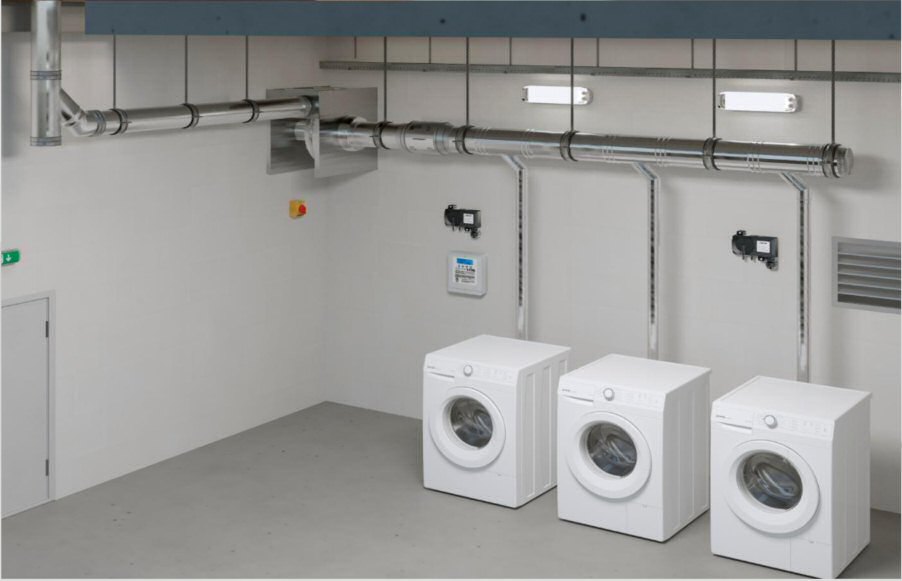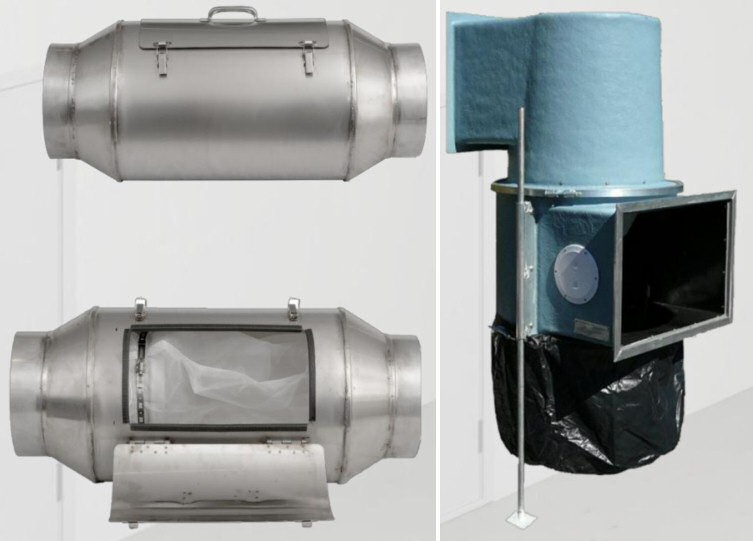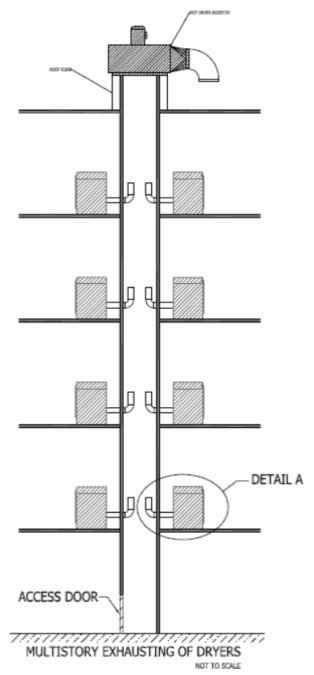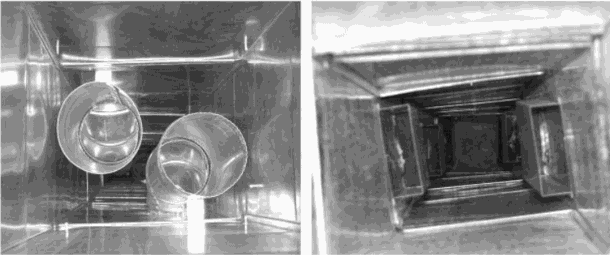We are all familiar with using a clothes dryer. You put in wet clothes, add heat and dry air, and eventually, your clothes are dry and ready to be put away. But what happens to all that moisture and air? In a single-family home, it is simply vented to the outside through a flexible duct and wall vent. Commercial and multi-family spaces pose different challenges and have different requirements which are driven by building codes as compared to single-family homes. We will take a look at these unique applications and discover the best methods to vent dryer exhaust.
Important Definitions
Laundry dryers are classified into two types:
- Type 1 dryers are those that are classified as “domestic” and are used in living environments such as single-family homes and individual apartments or condominiums.
- Type 2 dryers are those that are classified as “public” and are used in businesses with direct public contact. Typical applications of Type 2 dryers are laundromats, common laundry rooms (apartment complexes, dormitories, etc.), and business laundries (hotels, health clubs, hospitals, etc.)
Type 2 “Public” Dryer Applications – Commercial Laundries
Commercial dryer manufacturers specify the exhaust requirements of their dryers to ensure that they operate correctly. Commercial dryers are designed to operate at a specific exhaust outlet pressure, usually between +0.10 and +0.30 in. w.c. As a result, manufacturers often specify that, ideally, each dryer should be exhausted individually, and the exhaust duct run should not exceed 15 equivalent feet. If multiple dryers are ducted together, you cannot exceed 15 feet of horizontal and 8 feet of vertical exhaust duct. These restraints are impractical for most commercial laundry applications. The solution to these restrictions is to use a mechanical exhaust system.
For single dryer installations, the use of a mechanical exhaust system allows you to increase the exhaust duct to almost any length, if you maintain the correct outlet pressure at the dryer. It also allows the dryer to be installed in almost any location, not restricting them near an outside wall. Typical exhaust system components for this application include a variable speed exhaust fan combined with a duct pressure sensor/controller that varies the speed of the fan to maintain a constant duct pressure. Exhaust fans designed for laundry service have removable access doors for lint clean out, variable speed EC (electronically commutated) motors, and are listed to UL 378 for safety draft equipment and UL 705 for power ventilators.
For multiple dryer installations, a common horizontal duct header can be used to tie all the dryers together.
Connector duct from each dryer to the header must have a smooth interior, connected to the header at an angle of no greater than 45 degrees, and cannot exceed 15 equivalent feet. The main header must be sized with a maximum pressure drop of 0.10 in. w.c. and cleanouts must be provided for lint removal. Typical system components include a variable speed exhaust fan, duct pressure sensor/controller, and optional lint collector. Lint collectors are available in low and high-capacity configurations, depending on the total system airflow.
One other consideration that should be addressed is make-up air. While a typical residential dryer exhausts approximately 200 cfm, commercial dryers can vent at much higher rates. Per IMC 2018, dryer installations with greater than 200 cfm of exhaust must be provided with a source of make-up air. This means that nearly every installation of Type 2 dryers will require make-up air. This can take the form of louvers or supply fans.
Supply louvers are the simplest means of providing combustion air. They must be sized, according to NFPA, with a minimum free area of 1 sq. in. per 1,000 BTUH total input rating of the dryer. Typical dryers have between 20,000 and 25,000 BTUH ratings requiring a louvered opening with of around 25 sq. in. Since the typical louver has about 56% free opening, that means that the louver needs to be about 45 sq. in. to allow for adequate combustion air. Although this may seem like the easiest way to handle the situation, there are other considerations that must be taken into account. Louvers are static and are always open to the outside. The dryers are usually not running 24/7 so dampers should be provided to shut off outside air when the dryers are not in use. As dryers turn on, the damper will open to allow outside air to enter the space. However, in partial load situations when not all dryers are operating, the louvers will be open, oversupplying the space with outside air. This could be uncomfortable for personnel during the winter or summer months.
A more precise way of supplying make-up air is through a supply fan ducted to the space. Combined with a controller, pressure transducer and outdoor sensor, a supply air system maintains neutral pressure in the laundry room and provides the precise amount of combustion air required per the dryer manufacturer’s recommendations. In partial load conditions, the controller modulates the supply fan to only provide the necessary amount of make-up air, keeping the occupants comfortable year-round, and providing energy savings with demand-controlled ventilation.
Type 1 “Domestic” Dryer Applications – High-Rise Systems
In high-rise applications, Type 1 dryers are located in individual single-family living spaces such as apartments or condominiums. Architects like to minimize penetrations through exterior walls, so the dryers are placed in the interior of the space making venting to the outside difficult. A common exhaust shaft is most often utilized for all dryers in the building. This shaft is then vented to the outside using a roof-mounted exhaust fan. These common exhaust ducts should only serve dryers, be independent of other exhaust systems, have a cleanout at the bottom, and a source of make-up air.
There are two main considerations that should be addressed when designing a high-rise exhaust system. The first design consideration is airflow. As we discussed earlier, maintaining the correct outlet pressure for each dryer is important for proper operation. It is unlikely that all dryers will be operating simultaneously, therefore a variable speed fan coupled with a duct pressure sensor is the best way to maintain the correct pressure.
The second design consideration is the shaft and dryer connections. Common exhaust shafts are required to be fire-rated per code. Since dampers are not allowed in the dryer exhaust duct, special considerations must be taken into account when making appliance connections to fire-rated shafts. The use of steel sub-duct risers that extend at least 22” vertically are an approved method. Low-profile versions have been developed that greatly reduce the footprint of these subducts within the shaft.
Designing exhaust systems for commercial and multi-story residences can create challenges. Brucker represents companies like LFSystems and Greenheck, which can provide the right products for your application. Contact the design professionals at Brucker to address any concerns that you may have up front and help layout the best system for your project.
- LFSystems. (2022, April). Laundry & High-Rise Exhaust. Fort Worth, TX.
- (ICC), I. C. C. (2018). IMC 504. Digital codes. Retrieved February 15, 2023, from https://codes.iccsafe.org/s/IMC2018/chapter-5-exhaust-systems/IMC2018-Ch05-Sec504
- NFPA, N. F. P. A. (2021). NFPA 101®. NFPA 101®: Life Safety Code®. Retrieved February 15, 2023, from https://www.nfpa.org/codes-and-standards/all-codes-and-standards/list-of-codes-and-standards/detail?code=101





Recent Comments